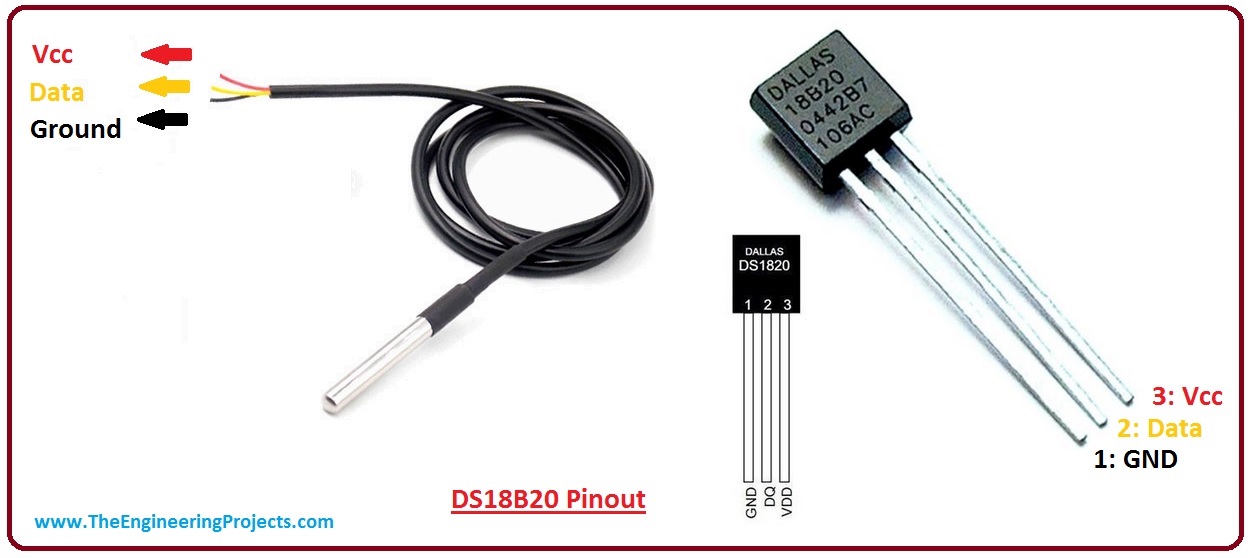Acqua technical documentation Buy
How to use the 1-WIRE bus on Acqua SOM
1-Wire is a device communications bus system designed by Dallas Semiconductor that provides low-speed data, signaling, and power over a single signal. 1-Wire is similar in concept to I2C, but with lower data rates and longer range.
1-Wire is typically used to communicate with small inexpensive devices such as digital thermometers and weather instruments. This article illustrates how to read a popular DS18B20 thermal sensor.
The Dallas/Maxim DS18B20 thermal sensor
The DS18B20 digital thermometer provides 9-bit to 12-bit Celsius temperature measurements. It communicates over a 1-Wire bus that by definition requires only one data line (and ground) for communication with a central microprocessor.
It has an operating temperature range of -55°C to +125°C and is accurate to ±0.5°C over the range of °10°C to +85°C. (read more on datasheet).
Wiring
| DS18B20 | Berta D2 Board |
|---|---|
| 1 - GND | GND |
| 2 . Data | PB5 |
| 3 - Vcc | 3V3 |
A 4.7kOhm pull-up resistor is requested between the Data and Vcc pins
We are using PB5 line just for example but any GPIO line can be used.
Install the kernel drivers
To enable the Kernel drivers (master and slave) follow this tutorial:
Using this command:
make arch=ARM menuconfig
and enable the Dallas 1-wire support and the Thermal family implementation as shown below:
Device Drivers --->
<*> Dallas's 1-wire support
1-wire Bus Masters --->
<*> GPIO 1-wire busmaster
1-wire Slaves --->
<*> Thermal family implementation
Configuring the kernel driver using the device tree
Edit the device tree source available on arch/arm/boot/dts/acme-acqua.dts of your kernel tree
and add these lines inside the apb section:
onewire_0: onewire_0 {
compatible = "w1-gpio";
gpios = <&pioB 5 GPIO_ACTIVE_HIGH>;
pinctrl-names = "default";
pinctrl-0 = <&pinctrl_onewire_0_default>;
status = "okay";
};
then add also these lines in the section board:
pinctrl_onewire_0_default: onewire_0_default {
atmel,pins =
<AT91_PIOB 5 AT91_PERIPH_GPIO AT91_PINCTRL_NONE>;
};
It is possible to change PB5 with the GPIO you intend to use):
Changing the gpio parameter you can change the GPIO to use as 1-wire bus
Any GPIO can be used as 1-wire bus. The pin used depends by the device tree definition
Read the temperature
The 1-wire driver automatically scans every 10 seconds if new sensors are plugged on the 1-wire bus.
For each 1-wire device detected a new directory is created on /sys/bus/w1/devices.
Type:
ls /sys/bus/w1/devices/
28-000005970839 w1_bus_master1
a thermal sensors has been found and their unique ID is 28-000005970839.
To read the temperature from each sensor type:
cat /sys/bus/w1/devices/28-000005970839/w1_slave
3f 01 4b 46 7f ff 01 10 7a : crc=7a YES
3f 01 4b 46 7f ff 01 10 7a t=19937
t=19937 indicates that the temperature read is 19.9 °C
Read the temperature each seconds in Python3
#!/usr/bin/python3
import os
import time
w1path = "/sys/bus/w1/devices/w1_bus_master1"
# Extract the sensor id
if not os.path.exists(w1path):
print ("1-wire bus not found")
print ("Check if the 1-wire bus is installed")
exit(1)
deviceList = os.listdir(w1path)
# for deviceId in deviceList:
# print(deviceId)
onewire_id=[deviceId for deviceId in deviceList if deviceId[0:2]=="28"]
# print(onewire_id[0])
# Read temp
while True:
f = open("/sys/bus/w1/devices/" + onewire_id[0] + "/w1_slave","r")
tString=f.read()
f.close()
if tString.find("NO")>=0:
print ("Wrong CRC")
exit(1)
p=tString.find("t=")
value =float(tString[p+2:-1])/1000
formatted_value = "{:.2f}".format(value)
print(formatted_value)
time.sleep(1)
Download
- acme-acqua.dtb Ready to use Device tree blob file to enable PB5 line as 1wire. Save this file inside the first partition microSD and reboot.
- acme-acqua.dts Device tree source used
- To compile the device tree blob from source follow this article Compiling Linux Kernel 5.15 LTS
Links

Systems designer, webmaster of www.acmesystems.it and founder of Acme Systems srl
Personal email: tanzilli@acmesystems.it
Web pages: https://www.acmesystems.it --- https://www.acmestudio.it
Github repositories: https://github.com/tanzilli --- https://github.com/acmesystems
Telegram group dedicated to the Acme Systems boards: https://t.me/acmesystemssrl






